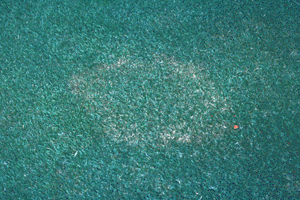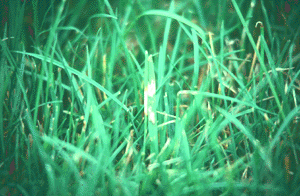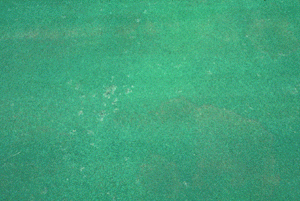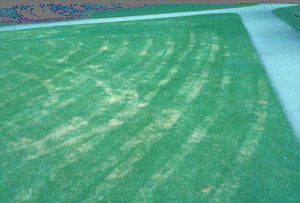

Brown patch of turfgrass is caused by the fungus Rhizoctonia solani Kuehn. All commonly cultivated turfgrasses in Nebraska are affected by this disease, but differences in susceptibility exist within cultivars of the various turfgrass species. Primary hosts are bentgrass, perennial ryegrass, tall fescue and annual bluegrass. Certain species of Rhizoctonia are capable of attacking turfgrass plants from seedling stage to mature plants and are pathogenic over a wide range of environmental conditions. In some literature, brown patch may be referred to as Rhizoctonia blight. In zoysiagrass, it is referred to as large brown patch.
 |
| Figure 1. Roughly circular patches typical of brown patch on taller-cut turfgrass. |
 |
| Figure 2. Irregularly-shaped leaf spot of brown patch (right) and bleached leaf spot of dollar spot. |
 |
| Figure 3. Brown patch symptoms on a bentgrass green. |
 |
| Figure 4. Spread of brown patch by mowing. |
On home lawns, golf course fairways and similar turfs, field expression of the disease is the presence of roughly circular patches of dead and dying grass (Figure 1). Diseased areas may encompass large portions of the turf. Turf with these patches appears somewhat "sunken." The grass in the center of the diseased patches may be less affected, giving the appearance of the "frog-eye" symptom commonly associated with summer patch. However, the presence of the characteristic brown patch leaf spot on individual blades should distinguish it from this disease. Also, the affected turf appears less matted than that affected by summer patch.
Green plants within the affected turf have grayish-colored leaf spots that are long, irregularly shaped and surrounded by a dark brown margin (Figure 2). Diagnosis of brown patch should be made not only on the characteristic leaf spot symptom, but also should include gross symptomatology of the affected turf, and, in some situations, culturing of the pathogen.
On bentgrass greens, symptoms appear as roughly circular, reddish-brown
patches that vary in size from 6 to 8 inches to a foot or more in diameter
(Figure 3). Infected grass blades first appear water-soaked and
purplish-green. They soon die and turn light brown. Occasionally, a grayish
"smoke ring" 1 to 2 inches wide and composed of wilting, webbed grass blades
marks the advancing margin of the patch. The smoke ring is best observed
in early morning while dew is present.
Table I. Fungicides for the management of Rhizoctonia brown patch.*
|
|
||
| Common Name | Some Trade Names | Professional (P)/
Homeowner (H) Use |
|
|
||
| Azoxystrobin | Heritage (Zeneca) | P |
| Benomyl | Benomyl (Hi Yield) | H |
| Benomyl Lawn Fungicide (Bonide) | H | |
| Benomyl Systemic Fungicide (American) | H | |
| Benomyl Spray (Security) | H | |
| Chloroneb | Chloroneb (Andersons) | P |
| Fungicide V (Scotts) | P | |
| Teremec SP (PBI/Gordon) | P | |
| Terraneb SP (Kincaid) | P | |
| Chlorothalonil** | Daconil 2787 (Zeneca) | P |
| Daconil 2787 Weather Stik (Zeneca) | P | |
| Daconil Ultrex (Zeneca) | P | |
| Manicure (LESCO) | P | |
| Thalonil (Terra) | P | |
| Turf Fungicide (Lebanon) | P | |
| Chlorostar (Regal) | P | |
| Cyproconazole | Sentinel (Novartis) | P |
| Fenarimol | Rubigan A.S. (Dow AgroSciences) | P |
| Patchwork (Riverdale) | P | |
| Flutolanil | ProStar (AgrEvo) | P |
| Iprodione | Chipco 26019 (Rhone-Poulenc) | P |
| Chipco 26GT (Rhone-Poulenc) | P | |
| Fungicide X (Scotts) | P | |
| Maneb | Pentathlon (Griffin) | P |
| Mancozeb | Fore (Rohm and Haas) | P/H |
| Dithane (Rohm and Haas) | P | |
| Mancozeb (LESCO) | P | |
| Protect T/O (Cleary) | P | |
| Junction (Griffin) | P | |
| Mancozeb Flowable (Bonide) | H | |
| Maneb Plus (Green Light) | H | |
| Fore Lawn & Ornamental Fungicide Spray (Acme) | H | |
| Myclobutanil | Eagle WSP (Rohm and Haas) | P |
| Golden Eagle (Scotts) | P | |
| PCNB | Defend 2F (Cleary) | P |
| PCNB 75WP (Cleary) | P | |
| Engage (United Horticultural Supply) | P | |
| Penstar 15G, FLO (Scotts) | P | |
| Revere (LESCO) | P | |
| Terraclor, Turfcide, Turfcide 400 (Uniroyal) | P | |
| Propiconazole | Banner MAXX (Novartis) | P |
| Banner GL (Novartis) | P | |
| Spectracide Immunex Fungicide Concentrate (Spectrum) | H | |
| Quartenary Ammonium Compounds | Physan 20 (Maril) | P |
| Thiophanate-methyl | 3336 (Cleary) | |
| Cavalier 2G, 50WSB, 4.5 F (LESCO) | P | |
| Fungo Flo, 50WSB Systemic Fungicide (Scotts) | P | |
| SysTec 1998 (Regal) | P | |
| Halt Systemic (Ferti-lome) | H | |
| Lawn Fungus Control (Scotts) | H | |
| Systemic Fungicide 3336 (Dragon) | H | |
| Bonomyl System Fungicide (Bonide) | H | |
| Thiram | Spotrete 75WDG, F (Cleary) | P |
| Lawn Disease Control (Bonide) | H | |
| Defiant (UCB) | P | |
| Triadimefon | Bayleton (Bayer, Anderson, Lebanon) | P/H |
| Granular Turf Fungicide (LESCO) | P | |
| Fungicide VII (Scotts) | P | |
| 1% Turf Fungicide with Bayleton (Rockland, Bonide) | P/H | |
| Accost (United Horticultural Supply) | P | |
| Bayleton Systemic Fungicide (LESCO) | P | |
| Fungi-Fighter (Monterey) | P | |
| Fungisol (Opti-Gro) | P | |
| Lawn Fungicide, Bayleton 1G (Howard Johnson's) | H | |
| Fung-Away (Green Light) | H | |
| Vinclozolin | Curalan (BASF) | P |
| Touch, (LESCO) | P | |
| Vorlan DF (Scotts) | P | |
| Chloroneb+thiophanate-methyl | Fungicide IX (Scotts) | P |
| Chloroneb+fenarimol | TwoSome Flowable Fungicide (LESCO) | P |
| Chlorothalonil+thiophanate-methyl | ConSyst (Regal) | P |
| Spectro 90WDG (Cleary) | P | |
| Propamocarb+chlorothalonil | LescoPar (LESCO) | P |
| Thiophanate-methyl+iprodione | Fluid Fungicide (Scotts) | P |
| Turf Builders plus Fungicide | H | |
| Thiophane-methyl+mancozeb | Duosan WP, WSB (Scotts) | P |
| Thiram+triadimefon | Fluid Fungicide III (Scotts) | P |
| Triadimefon+metalaxyl | Fluid Fungicide II (Scotts) | P |
|
|
||
| *Fungicides listed in Table I represent the
best information available. No criticism is intended of products not listed,
nor is endorsement by the University of Nebraska given to those listed.
Read and follow all product label directions.
**Cannot be used on home lawns. |
||
|
|
||
Electronic version issued August 1999
pubs@unl.edu
Issued in furtherance of Cooperative Extension work, Acts of May 8 and June 30, 1914, in cooperation with the U.S. Department of Agriculture. Elbert C. Dickey, Director of Cooperative Extension, University of Nebraska, Institute of Agriculture and Natural Resources.
University of Nebraska Cooperative Extension educational programs abide with the non-discrimination policies of the University of Nebraska-Lincoln and the United States Department of Agriculture.